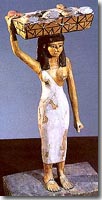| |
|||||||
|
|||||||
TRANSPORTATION IN ANCIENT
EGYPT |
|||||||
 |
|
||||||
Travel speed on the Nile depended on the direction of the journey -upstream or downstream - the strength of the wind and current, and the boat and crew. In antiquity, the average speed sailing up-river was between 25 to 44 miles (40 to 70 km) per day. The ancient Egyptians usually did not travel on the Nile at night. Navigation on the Nile was fairly safe, but the open sea presented
greater dangers. Early sailors clung to the coastlines. Eventually,
seafaring peoples like the Minoans, Phoenicians and Indians pioneered
cross-ocean routes. By the New Kingdom ships regularly sailed to Crete,
Greece, Punt (Horn of Africa), Arabia and India. Ships sailing before
the wind could reach speeds of about 6 mi/10 km per hour at best, travelling
somewhat more than 124 mi/200 km a day if they sailed through the night. |
|||||||
The simplest kind of boat in ancient Egypt was the skiff, made up of bundles of buoyant papyrus tied together. They used these for fishing, hunting and short trips along the river. Larger ships had oars and sails. Made of acacia planks roped together, the wood swelled in water making them watertight. These were used for the massive blocks of stone quarried near the First Cataract and transported easily all along the Nile and the Delta. Boats figured prominently in Egyptian religion. During festivals (such as Opet) gilded barges moved images of the gods from temple to temple. Boats transported royal and noble mummies across the Nile to the tombs on the West Bank. Even Ra, the sun god, travelled by boat acroos the sky every day - the "Boat of a Million Years". |
 |
||||||
FERRIES The width of the Nile and its arms made bridges rare. VEHICLES AND BEASTS For transport most people used donkeys. Domesticated early in Egyptian history, everyone seems to have used these surly beasts, even pharaohs. Camels appeared very late, after the Persian and Greek invasions. For heavy loads (statues, obelisks and the like) where canals could not be dug, Egyptians used wooden sledges dragged by huge gangs of men. They also used sledges for smaller loads. On the packed, sun-baked ground they poured river water in front of the sledges to make a slick and smooth surface. Rollers were rare, especially by Middle Kingdom times, because of deforestation and the scarcity of wood in Egypt. Elites often rode in litters (carrying chairs) borne by servants. Sometimes they strapped these to the backs donkeys.
|
|||||||
 |
|
||||||
Home | Nile Valley | Dynasties | Wealth | Divinity | Temples | Hieroglyphs | Mysteries
|
|||||||